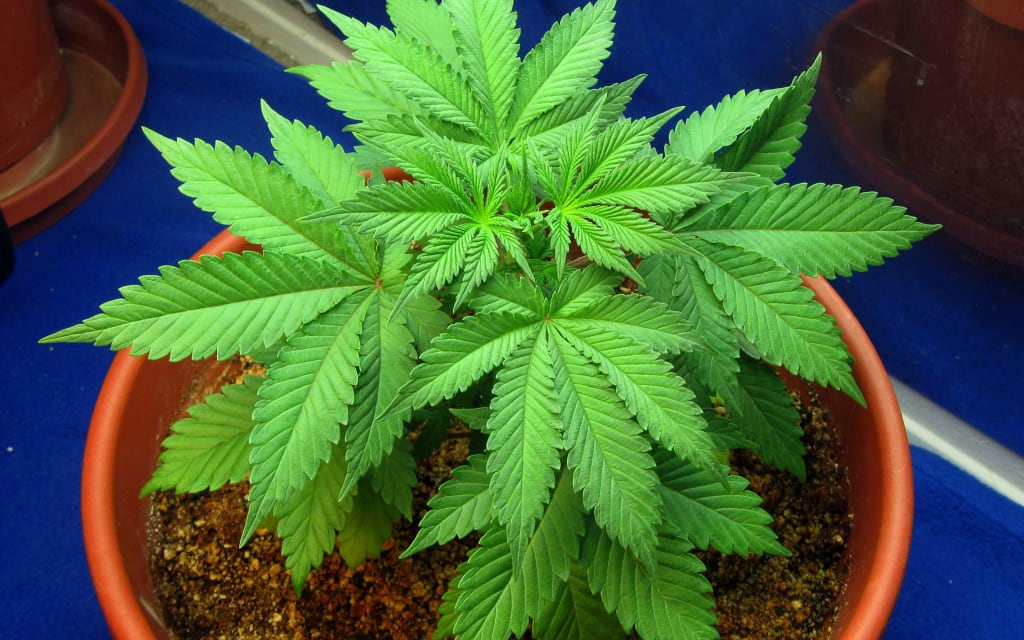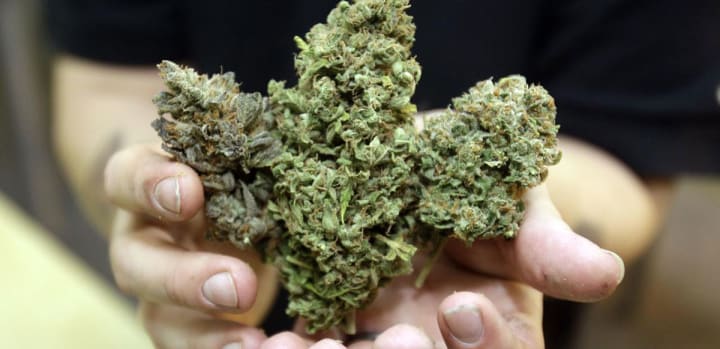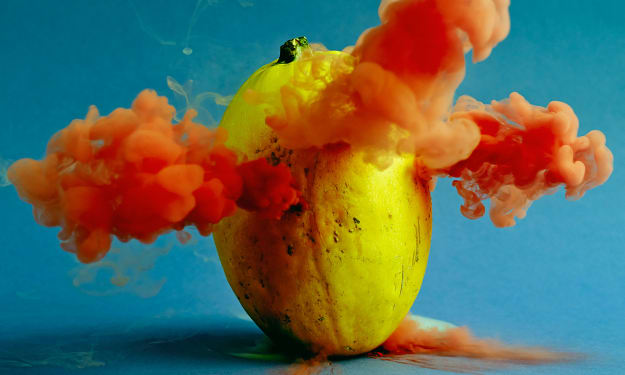
Money doesn’t grow on trees, but luckily marijuana does. The simple idea of picking your own nugs has forced every true weed aficionado to dream of tending his own ganja garden. Like having a chicken coop in your backyard with fresh eggs every morning, there’s nothing like waking up to the smell of newly-picked OG Kush. The main problem holding potential growers back, besides the legal issues, however, is the complex growing process. One cannot simply toss a couple of seeds in the ground and wake up to a fully-grown marijuana plant the next day. This isn’t the world of “Jack and the Giant Beanstalk,” although some pot smoking might explain Jack’s supposed adventure into the clouds. Therefore, a fully-grown weed plant will take some serious time and care before it starts producing the herbs of the Gods.

Image via Herb
A Different Kind of Green Thumb
In colloquial usage, green thumb is a figurative term used to describe a certain magic involved in the growing of plants. For example:
“Have you seen Lovely Linda's lentils? That lady has some kinda green thumb!”
The gist of this insight, of course, has nothing to do with the physical characteristics of Lovely Linda's digits—however profound they may be; it simply expresses a wonder at her ability to grow lentils.
To the sinsemilla cultivator, green thumb is a literal term used to describe the thumb (and fingers) after a day's work on the plants.
“Far out! Look at my hand. That's what I call a real green thumb!”
Much of the cultivator's work consists of physically manipulating the plants—culling old sun leaves, topping new growth, or just saying “high.” The plants, like all living things, love to be loved, and demonstrate this gratitude by leaving a layer of sweet, sticky resin on the fingertips of the cultivator.
As the season progresses and the plant's need for attention intensifies, the layer of sweet, sticky resin will increase in both quantity and potency.
At the end of a day, the cultivator might rub the sticky green resin from the thumb, stick it in a pipe, and say something like:
“WOW!! That green stuff on my thumb is some kinda magic!”
Cannabis-the-plant is strong, intelligent, and adaptable. These attributes enable the plant to survive in an environment often cruel and unforgiving—nature.
If chewed-up by hungry critters or beaten down into the mud by heavy rains, an otherwise healthy plant can react, adapt, and survive. This strength can be exploited to manipulate the plant's growth.
Say the garden is surrounded by a six-foot high fence. One neighbor is a deputy sheriff; the other is president of the local chapter of CAMSHAFT (Citizens Against: Marijuana, Sex, Hilarity, Ants, Fatts, and Thunder).
There are half a dozen Oaxacan seedlings in the garden. Left to their own inclinations, they would grow to a healthy 18 feet and create an unhealthy neighborhood environment. By manipulating them, growth is directed within the bounds of propriety and the plants allowed to mature in peace—vintage Darwin, almost.
Manipulating growth will not influence potency; it will, rather, enable one to keep the plants' energy focused on the ultimate goal of yielding flowers. For the home-grower, it means getting as much as possible out of those few seedlings growing in the garden.
Manipulating for Shape

Photo via Best Weed in the World
Cannabis will grow naturally into the conical shape of a young pine tree. Variations on this shape are determined by the microclimate in which a seed strain evolved. Mexican and Thai varietals tend to grow tall with narrow, sparse networks of branches. Colombian strains tend to produce shorter plants with broader, more extensive networks of branches. High-latitude Indica varietals (hash plants) may yield dwarf-like plants that only reach 4 to 5 feet.
Ideally, one should select a seed strain that will yield a plant compatible with the garden’s requirement of privacy. When that choice is not possible, or is undesirable, the plant can be manipulated into a shape less conspicuous than an electric-green-pine tree that can be seen from 30 miles away... at night... in a storm…
Pruning is the removal of one section of plant to stimulate growth in another. By pinching new growth at the top of a plant's stem, or branch ends, energy is forced into the two nodes immediately below—one branch becomes two. If pruned several times, a tall, sparse shape can be forced into a short, full shape.
Cordoning is a method of training the plant's growth through the use of supports. Because of its fibrous stalk, the cannabis plant is amenable to being bent into an arch and secured to the ground, or the fence, or between two walls, or... If manipulated in gradual stages, a plant's shape can be altered completely by the time it goes into flower.
The logistics of privacy are unique; where one garden requires a short, bushy plant, another will need a tall, thin one. To be successful in fulfilling the need, a cultivator can adopt the sensitivity of an artist and sculpt the plant's shape to fit the garden.
Manipulating for Health
The cannabis plant can readily protect itself from many of the elements that threaten its health. It can guard against insects, heal broken branches, and ward off diseases. These tasks can use up a lot of energy; through careful handling, a cultivator can help the plant maintain good health and keep its energy focused on the production of new growth.
When seedlings are transplanted, mishandling or exposure to air can shock the delicate root system. To aid recovery, several of the large sun leaves can be pruned. This will reduce the demand on the root system and encourage quicker healing. It should be noted that pruning sun leaves also reduces the ability to process energy. If pruned, keep the seedling out of the direct sunshine until it has recovered. A plant suffering broken or diseased branches may also be helped. Broken branches may be pruned, staked, and splinted. Diseased branches may be pruned away entirely. Pruning, staking, and splinting can keep vital energy focused on new, more promising growth. It will be especially helpful in the marginal conditions of greenhouses and “lighthouses.”
In climates with heavy rains, the taller varietals like Mexican and Thai will find it tough going in the late season. Rain will collect in the flower clusters and increase the weight on the plant to where it must bend and break. By looking ahead, one can avoid this disaster by pruning back during the green-growth stage for a shorter, more durable plant. By pruning a few old sun leaves, one can increase the exposure of sunshine and fresh air. This will aid further development of branching and help the cultivator spot harmful insects. With the denser plants like Colombian, pruning a few old sun leaves can help a lot.
Manipulating for Maximum Yield

Photo via Grow Med University
To maximize yield, a plant must be given as much food, water, and light as it wants. Ideally, a plant should be located to receive as much light as possible; even then, pruning and cordoning will increase exposure.
Pruning sun leaves is a subject of considerable debate. Most experts maintain that pruning leaves deprives the plant of energy-producing capabilities. Sun leaves grow directly below the nodes of developing branches. They provide energy for the new growth. If pruned too soon, the new branches will be deprived of energy to develop. Once the branch has developed enough to generate sun leaves of its own, it may deprive the original leaf of light. The old leaf will turn a dull green, then yellow. By being sensitive to this process, the old leaf may be pruned as soon as possible. This will allow more light to reach the interior branches and provide more nutrients for developing growth.
Cordoning can also increase a plant's exposure to light. By gently bending the plant and branches into a position of maximum exposure, then tying them into place, a cultivator will increase the amount of flowers a plant will yield. Cordoning for exposure to light is especially critical in the marginal conditions of green and light houses. To reach the source of light, plants will literally stretch themselves thin and collapse if not directed with supports.
In one high-latitude greenhouse, the plants had stretched to the 18-foot ceiling by September. By harvest, the large colas crept along the fiberglass ceiling for another two feet. To reach light, the bottom sections of plant stretched to incredible lengths. The bottom branches, for instance, were eight-feet-long and extremely thin.
For maximum production, cultivators can spin a web of support throughout the greenhouse. By doing so, you may enable parts of the plant to produce flowers that otherwise could not.
Manipulating Flower Structure
The shape of flower clusters a plant will produce can be altered through manipulation. Flowering characteristics are determined through heredity. For example, some Mexican varietals will yield long, massive clusters, while the Colombians tend to yield smaller, lacy clusters. The largest flower clusters a plant will produce can be altered through manipulation.
The largest flower cluster (colas) any varietal can produce will come from the tall, unpruned plant. The clusters will develop at the top of the stem and at the end of the branches. To cultivate this type of flower structure, the plant should be manipulated through cordoning rather than pruning.
By pruning a plant, one increases the number of branches and hence, the number of flowers. All other things being equal, increasing the number of branches decreases proportionately the size of flower cluster it can yield. Again, yield is a function of exposure to light. Manipulating the plant for the shape of the flower is, for the most part, an aesthetic control.

Photo via Green Rush Daily
Manipulating Tips
1) Plan Ahead. Begin when the plant is young and work in gradual, controlled steps. Allow the plant time to react and adapt—then learn from it. By the flowering stage, the plant should be shaped and ready to produce. Pruning and bending at this time will only detract from the business at hand.
2) Make Clean Cuts. Prune 4" above the branch node. Use your thumbnail and forefinger, or for thick stems and branches, use a pruning shear. Clean cuts are easy to mend, while ragged tears are not.
3) Prune in the Heat. Metabolism is at its peak. The plant can quickly disinfect and seal the wound. Cool weather means more work and increases the possibility of infection.
4) Be Sensitive. An over-pruned plant will result in stunted growth (bonsai) and possible sex reversal.
Manipulating the cannabis plant should be thought of as a domestication process—a process of taking something wild and free and bringing it on home. In that sense, the harvest is a product of the cultivator as well as the plant.
Try Your Own Green Thumb
Tending to your marijuana plant might be hard work, but the product serves as an appropriate reward. Toking on a freshly-picked joint will calm any overtired grower with just a couple of puffs. Homegrown bud is always the best bud for one major reason: you grew it yourself! Tomatoes, cucumbers, and basil are the plants of yesterday; White Widow, Amnesia Haze, and every other strain are the herbs of tomorrow’s garden. If you really are the weed enthusiast you claim to be, growing your own organic herb is the next step on the road to marijuana heaven. Tomorrow morning, why not have a side of eggs with your freshly-picked, AM blunt?
About the Creator
Ed Green
Gynecologist. Amateur Farmer and weed whacker. Loves figure skating and Liza Minnelli. Bakes amazing brownies.






Comments
There are no comments for this story
Be the first to respond and start the conversation.